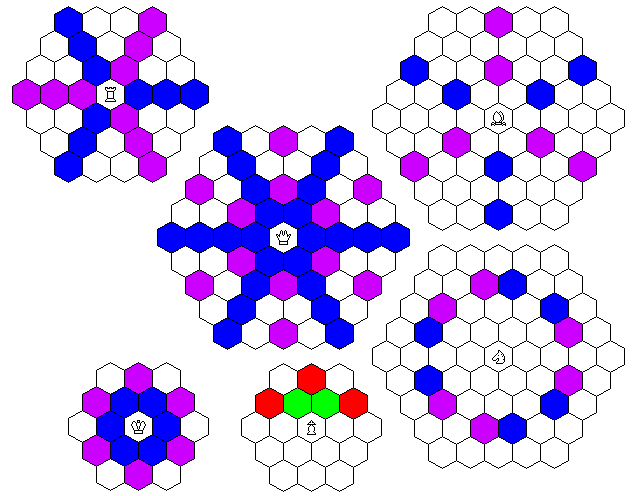
The previous page dealt with versions of Hexagonal Chess in which a side of the hexagon pointed in the forwards direction of movement. Some versions of Hexagonal Chess instead rotate the hexagon through 90 degrees, so that the hexagons are in orderly ranks.
In such a version of Hexagonal Chess, it is possible for the pieces to retain moves which are largely closely analogous to those in conventional Chess, as shown in the diagram below:

The Pawn's move in this diagram is the only one that differs from moves we have already seen on the previous page other than in orientation. A Pawn has two choices of forwards single-step Rook move, for moving without capturing, and three choices of forwards single-step Bishop move for capturing only.
A version of Hexagonal Chess was devised in 1953 by Helge E. De Vasa which used these moves. Its board and initial array are shown below:
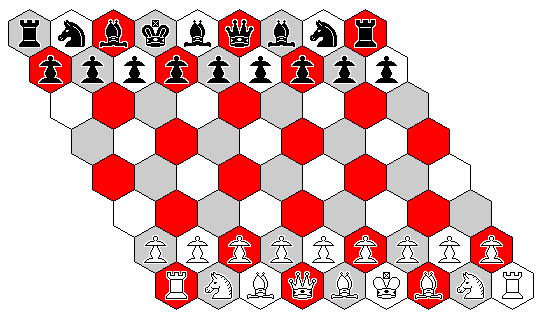
The King moves two spaces when castling Kingside, but three when castling Queenside. The pawns can move two steps on their first turn, and are subject to en passant capture if they elect to do so.
This orientation of the board, however, also lends itself to a set of moves that is very different from those which are geometrically analogous to those of normal Chess.
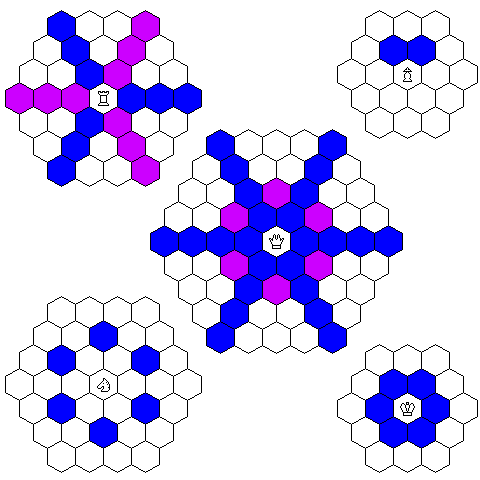
Thus, in the diagram above, since the Pawn has two different forwards moves available to it, it simply moves as it captures to those two squares.
The King moves one step to an adjacent hexagon.
Only the Rook move is unchanged.
Since a diagonal step involves moving to a hexagon which does not touch the hexagon one has come from, even at a corner, that move can be regarded as like a Knight's move, and so, in this set of moves, a single diagonal step is the move given to the Knight, and there is no Bishop.
In 1912, the hexagonal board was used for a form of three-player Chess by Sigmund Wellisch with these moves:
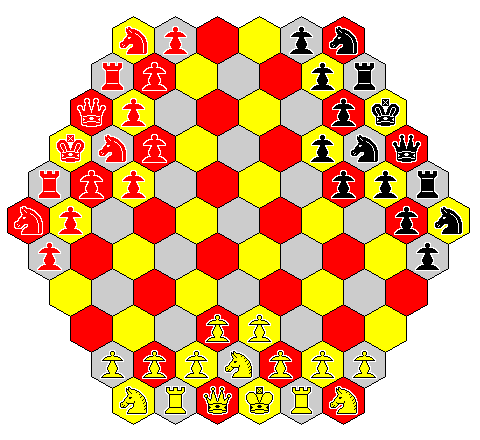
Note that the position of the red pieces is that shown in D. B, Pritchard's Encyclopedia of Chess Variants; the relationship between the red and black pieces is flipped over in the illustration in The Oxford Companion to Chess by Hooper and Whyld.
Pawns do not have a double-step first move. Castling involves the King and the Rook exchanging places.
Except that I called the Rooks Eagles, and the Knights Bishop-Knights, the first alternate form of Chess that I had ever thought to devise, many years ago when I was in high school, had these moves for the pieces. The layout and board were as follows:

I was originally going to call the game Chinese Chess, not knowing that Hsiang Ch'i had a prior claim to that appelation, but when I learned of that, I hastily changed the name of the game to Chinese Checkers Chess.
Neither pawn-two nor castling apply; Pawns promote only on those squares from which they can no longer move.
Of course, that is a rather large board for an array of only ten men, so I increased the number of men in the array by adding four new pieces, each of which could only move two steps along Rook lines. These pieces are shown in the diagram below by upside-down Rooks:
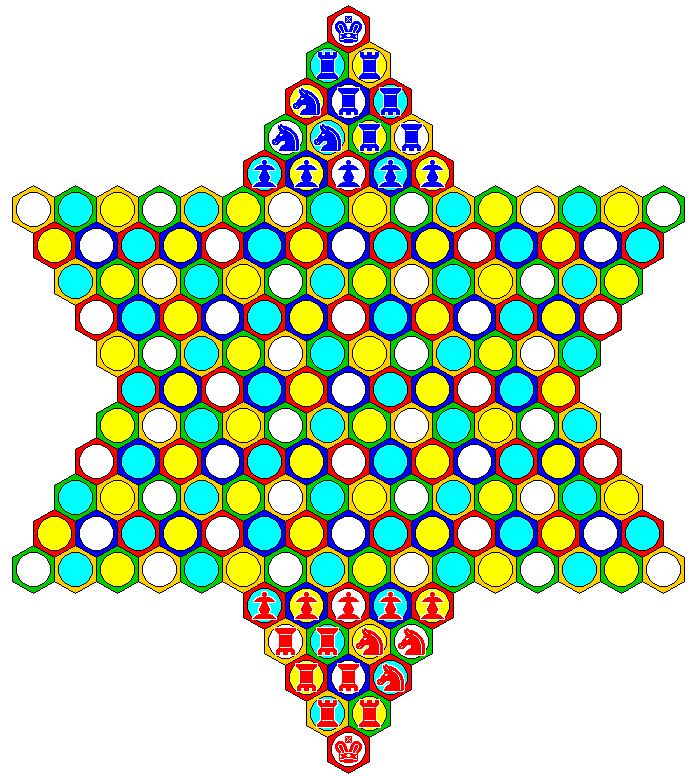
Note that these pieces can only reach one-quarter of the spaces on the board; these spaces are indicated by a scheme of coloring that is orthogonal to the set of three colors used for the Bishop-Knights in this game, and Bishops in games of Hexagonal Chess in general. That is, all 12 combinations of one of the four colors from one scheme, and one of the three colors from the other scheme, can be found on the board.
In addition to two players, three or six players, or even four players, can play on this board. Four players would leave two points unoccupied, and one of each pair of adjacent players would have a reflected array, so that adjacent players have their Bishop-Knights closer together.
There is no Castling or Pawn-two, and stalemate is a win for the stalemating player, as this was a simple game without the extra features of Chess.
While the contrast between the four colors defined by the Dabbaba and the three colors defined by Bishops (or Ferses called Knights, as the case may be) is of interest, an array in which the conventional Knight was brought back, and one had Bishops rather than Ferses and Dabbaba-Riders rather than Dabbabas, and with a somewhat smaller board, would doubtless be a more interesting game making use of these ideas.
With the following set of moves,
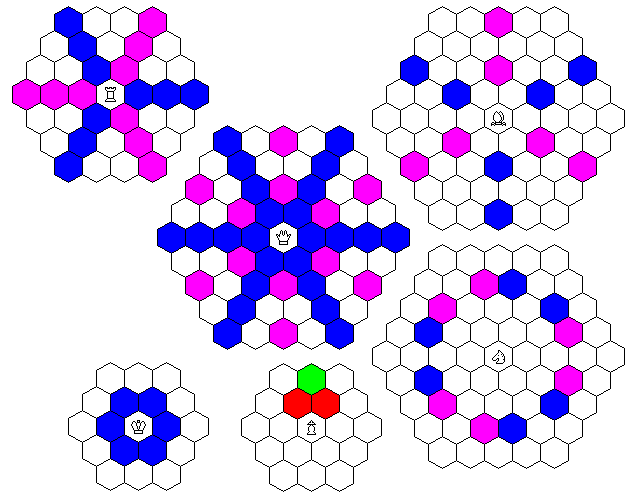
however, with the unusual feature that the pawn moves in one direction, diagonally forwards, but captures in two directions, orthogonally forwards, as well as with the Wellisch orthogonal-only King move, but with the moves geometrically analogous to those of ordinary Chess, as in Gliński hexagonal chess for the remaining pieces, I feel it is possible to construct a form of hexagonal chess that in many respects (but with one exception) more strongly resembles conventional Chess in its general play than any other.
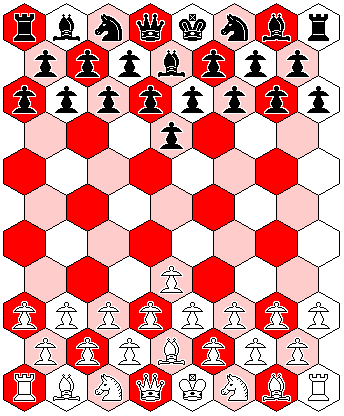
Castling is permitted, with exactly the same rule as in conventional Chess!
The new Pawn move, combined with the Pawn array as shown, allows for doubled Pawns to result from a Pawn capture in much the same way as in conventional Chess. But to achieve this, the one great discrepancy between this variant and conventional Chess results: in order to have an initial array with one Pawn on every file, it is necessary to have two ranks' worth of Pawns in each array, so each side has three Bishops and fifteen Pawns.
That the Bishops are on the outside, and the Knights are on the inside, in order that the Bishops are of all three colors, is another difference, but a trivial one.
One special rule is required in order to clear up how Pawn promotion works. The normal forwards move of a Pawn, one space forwards diagonally, advances the Pawn by two ranks. Instead of having Pawns promote on the last two ranks of the board, I've decided it is more reasonable to permit a Pawn on the second-last rank of the board to move one space orthogonally forwards, its normal capturing move, simply to move as well as to capture, so that promotion need only take place on the final rank.